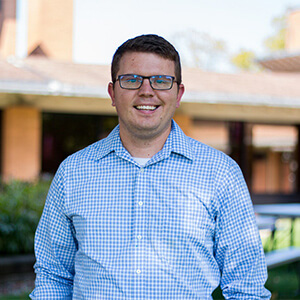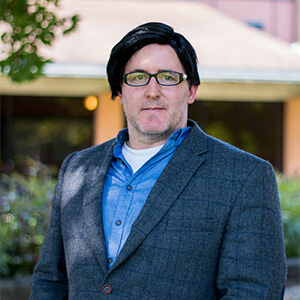
Concordia University Ann Arbor faculty members are furthering their fields of study through scholarship pursuits, and tomorrow, CUAA will showcase 12 of the efforts currently underway.
A Faculty Scholarship Seminar Presentation session will take place from 11 a.m. to 3:30 p.m. Wednesday in the Manor Ballroom. Over a dozen faculty and staff members will present on a range of topics in the areas of discovery, integration, application, and teaching.
Here’s a glance at the efforts being taken on by professors at CUAA. Click here to view a complete presentation schedule.
 1. “Synthesis of a Functionalized Piperdine Via Aza-Prins Cyclization”
1. “Synthesis of a Functionalized Piperdine Via Aza-Prins Cyclization”
Author: Dr. Alex Martin, assistant professor of natural science
Abstract summary: Piperdines are an organic compound that can serve as a major component in a wide range of active pharmaceutical ingredients. This new method attempts to produce these chemicals, utilizing a more efficient procedure that can open the door to a vast library of potential medications, without changing the overall synthetic strategy.
 2. “College Student Mental Health & Wellness: Prevalence of Disorders, Recognition of Concerns”
2. “College Student Mental Health & Wellness: Prevalence of Disorders, Recognition of Concerns”
Author: Timothy Neal, MS, AT, ATC, CCISM, assistant professor of health and human performance
Abstract summary: Attending college can be a powerful, overwhelming, and at times a distressing event for a student. Given that one in every four young adults can meet the criterion for a mental health disorder annually in the U.S., experiencing the stress of college life and numerous expectations as a student can exacerbate an existing mental health condition, or serve as a triggering mechanism to develop a mental health disorder. College faculty and staff should develop an appreciation for the psychological challenges that bring on mental health concerns in students. This presentation will provide an awareness of this challenge facing college students and introduce skills to identify a potential issue and to refer them into mental health care.
 3. “Analyzing Family Photographs: A Pre-writing Strategy for Memoir and Creative Nonfiction”
3. “Analyzing Family Photographs: A Pre-writing Strategy for Memoir and Creative Nonfiction”
Author: Dr. Georgia Kreiger, professor of English
Abstract summary: Kreiger articulates a theory of the family photograph as an artistic representation open to analysis and interpretation and offers a methodology for using family photo analysis as a pre-writing strategy for memoir and other creative nonfiction writing.
 4. “What’s at Stake? Gallows and Hanging or Poles and Impaling: ץ and תָּלָּה in Esther”
4. “What’s at Stake? Gallows and Hanging or Poles and Impaling: ץ and תָּלָּה in Esther”
Author: Rev. Dr. Philip Werth Penhallegon, professor of theology
Abstract summary: In translation, word choice matters. In the biblical book of Esther, the words עֵץ and תָּלָּה are usually translated “gallows” and “hanging.” However, based on linguistic, historical, and narrative evidence, they are best translated “pole” and “impaling.” This correction leads to an all-around better reading of Esther.
 5. “Leadership in Crisis”
5. “Leadership in Crisis”
Author: Dr. Timothy Pies, professor of education
Abstract summary: This presentation explores the inability of leaders to effectively respond to today’s growing number of man-made and natural disasters. Listerners will learn of the 10 types of crisis stages while identifying ways to mitigate or eliminate them.
 6. “Intermittent Use of Antimicrobial Socks Does Not Decrease Microbial Prevalence in Student Athletes: A Pilot Study”
6. “Intermittent Use of Antimicrobial Socks Does Not Decrease Microbial Prevalence in Student Athletes: A Pilot Study”
Authors: Dr. Lance Shultz, assistant professor of natural science; Malloree Ambs
Abstract summary: Microbial infections of the skin are a common problem. Antimicrobial garments, including socks, are marketed that claim to be able to decrease microbial prevalence. The researchers tested this claim in a population of student athletes and found that these particular antimicrobial socks were unable to decrease microbial prevalence when worn intermittently.
 7. “Bête comme la Paix?: Functions and Failures of the Treaty of Aix-la-Chapelle, 1748″
7. “Bête comme la Paix?: Functions and Failures of the Treaty of Aix-la-Chapelle, 1748″
Author: Dr. Matt J. Schumann, adjunct instructor
Abstract summary: The 1748 Treaty of Aix-la-Chapelle coined the phrase: Bête comme la paix, or ‘stupid as the peace’. But was it so stupid? Re-examining the circumstances of the treaty’s creation reveals key aspects of 18th century diplomatic culture, a possible corrective to the treaty’s poor reputation, and both strategic and rhetorical constraints on peacemaking that may still be relevant today.

 8. “Determining the Primary Study Strategies of Students in a College-level A&P Course and its Connection to Academic Performance”
8. “Determining the Primary Study Strategies of Students in a College-level A&P Course and its Connection to Academic Performance”
Authors: Dr. Jeffery M Schwehm, associate professor of natural science; Jonathan Reasor, assistant professor of natural science; Royden Pett
Abstract summary: The researchers surveyed students in the Anatomy and Physiology classes at Concordia University regarding their preferred study styles. Their interest was to determine which study methods are most successful and to inform professors how teaching strategies may increase learning and retention of information, given these preferences.
 9. “Imagining the Revolution: History and Heroism in Three 19th Century Accounts of America’s Revolutionary Past”
9. “Imagining the Revolution: History and Heroism in Three 19th Century Accounts of America’s Revolutionary Past”
Author: Dr. Robert Hill, assistant professor of history
Abstract summary: Most readers are familiar with Washington Irving’s classic story of “Rip Van Winkle,” the man who sleeps through the American Revolution only to awaken 20 years later to find a bewildering adn radically altered society than the one he lived in before. Published in 1819, it was one of many 19th century literary works that historicized and romanticized the Revolutionary era. These historical romances helped enshrine both facts and enduring myths in the public’s mind. This paper examines three other works (Parons Weems’ “The Life of Washington”; Nathaniel Hawthorne’s “Legends of the Province House”; and Herman Melville’s “Israel Potter”) and demonstrates their seminal influence in shaping Americans’ understanding of the revolutionary past.
 10. “A New Messiah? The Representation of Automobiles in Farm Security Administration Photography”
10. “A New Messiah? The Representation of Automobiles in Farm Security Administration Photography”
Author: Dr. Robert Hill, assistant professor of history
Abstract summary: Hill’s paper explores the depiction of automobiles in photographs taken by Farm Security Administration photographers during the Great Depression. Since the early 20th century, the automobile has appeared as a potent symbol in American arts and letters, often as a representation of freedom, success, sexuality, and mobility. Photographers working for the FSA subverted this icon of the American Dream with stunning shots, for example, of automobile graveyards and beat-up jalopies.


 11. “Better Teamwork, Better Patient Outcomes: Inter-professional Simulation Education as a Strategy for Preparing Future Nurses”
11. “Better Teamwork, Better Patient Outcomes: Inter-professional Simulation Education as a Strategy for Preparing Future Nurses”
Authors: Dr. Cindy Fenske, dean of nursing; Dr. Margaret McLaughlin, associate professor of nursing; Dr. Mihaela Zegrean, assistant professor of nursing; Dr. Anita Simmons, director of simulation and inter-professional education; Joseph Yaksich, simulation specialist; Betsy Cambridge, simulation specialist; Ben Oliver, chief simulation specialist
Presenting: (left, top) Dr. Anita Simmons, Dr. Mihaela Zegrean, Dr. Margaret McLaughlin
Abstract summary: New graduate nurses are often reluctant to speak up about patient concerns when working within a health care team. Teaching teamwork training skills along with the use of simulated inter-professional experiences can help.
 12. “Reading Spiders: The Soul in a World of Small Things in ‘Sinners in the Hands of an Angry God'”
12. “Reading Spiders: The Soul in a World of Small Things in ‘Sinners in the Hands of an Angry God'”
Author: Dr. Emelia Abbe
Abstract summary: What do insects, spiders, and Isaac Newton have to do with the early American church? In this project, Abbe uses “Sinners in the Hands of an Angry God,” a sermon by Jonathan Edwards, to show the ways in which Puritan ministers and their congregations used scientific methods and ideas to create a community identity.
— This story is written by Kali Thiel, director of university communications for Concordia University Ann Arbor and Wisconsin. She may be reached at kali.thiel@cuw.edu or 262-243-2149.
If this story has inspired you, why not explore how you can help further Concordia's mission through giving.